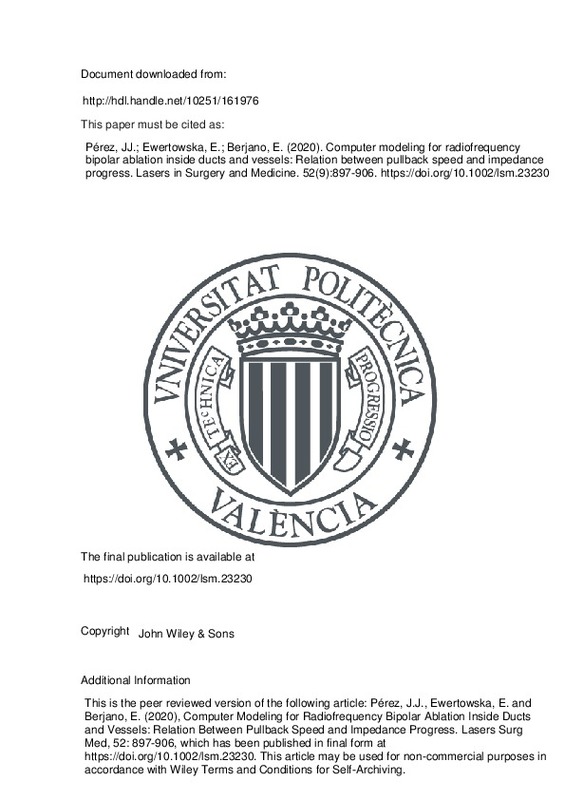Boon, R., Akkersdijk, G. J. M., & Nio, D. (2010). Percutaneus treatment of varicose veins with bipolar radiofrequency ablation. European Journal of Radiology, 75(1), 43-47. doi:10.1016/j.ejrad.2010.04.015
Atar, M., Kadayifci, A., Daglilar, E., Hagen, C., Fernandez-del Castillo, C., & Brugge, W. R. (2017). Ex vivo human bile duct radiofrequency ablation with a bipolar catheter. Surgical Endoscopy, 32(6), 2808-2813. doi:10.1007/s00464-017-5984-0
Larghi, A., Rimbaș, M., Tringali, A., Boškoski, I., Rizzatti, G., & Costamagna, G. (2019). Endoscopic radiofrequency biliary ablation treatment: A comprehensive review. Digestive Endoscopy, 31(3), 245-255. doi:10.1111/den.13298
[+]
Boon, R., Akkersdijk, G. J. M., & Nio, D. (2010). Percutaneus treatment of varicose veins with bipolar radiofrequency ablation. European Journal of Radiology, 75(1), 43-47. doi:10.1016/j.ejrad.2010.04.015
Atar, M., Kadayifci, A., Daglilar, E., Hagen, C., Fernandez-del Castillo, C., & Brugge, W. R. (2017). Ex vivo human bile duct radiofrequency ablation with a bipolar catheter. Surgical Endoscopy, 32(6), 2808-2813. doi:10.1007/s00464-017-5984-0
Larghi, A., Rimbaș, M., Tringali, A., Boškoski, I., Rizzatti, G., & Costamagna, G. (2019). Endoscopic radiofrequency biliary ablation treatment: A comprehensive review. Digestive Endoscopy, 31(3), 245-255. doi:10.1111/den.13298
Mizandari, M., Kumar, J., Pai, M., Chikovani, T., Azrumelashvili, T., Reccia, I., & Habib, N. (2018). Interventional radiofrequency ablation: A promising therapeutic modality in the management of malignant biliary and pancreatic duct obstruction. Journal of Cancer, 9(4), 629-637. doi:10.7150/jca.23280
Belghazi, K., Pouw, R. E., Koch, A. D., Weusten, B. L. A. M., Schoon, E. J., Curvers, W. L., … Bisschops, R. (2019). Self-sizing radiofrequency ablation balloon for eradication of Barrett’s esophagus: results of an international multicenter randomized trial comparing 3 different treatment regimens. Gastrointestinal Endoscopy, 90(3), 415-423. doi:10.1016/j.gie.2019.05.023
Gianni, C., Chen, Q., Della Rocca, D., Canpolat, U., Ayhan, H., MacDonald, B., … Al-Ahmad, A. (2019). Radiofrequency Balloon Devices for Atrial Fibrillation Ablation. Cardiac Electrophysiology Clinics, 11(3), 487-493. doi:10.1016/j.ccep.2019.05.009
Andaluz, A., Ewertowska, E., Moll, X., Aguilar, A., García, F., Fondevila, D., … Burdío, F. (2019). Endoluminal radiofrequency ablation of the main pancreatic duct is a secure and effective method to produce pancreatic atrophy and to achieve stump closure. Scientific Reports, 9(1). doi:10.1038/s41598-019-42411-7
Burdío, F., Dorcaratto, D., Hernandez, L., Andaluz, A., Moll, X., Quesada, R., … Berjano, E. (2016). Radiofrequency-induced heating versus mechanical stapler for pancreatic stump closure:in vivocomparative study. International Journal of Hyperthermia, 32(3), 272-280. doi:10.3109/02656736.2015.1136845
Braithwaite, B., Hnatek, L., Zierau, U., Camci, M., Akkersdijk, G., Nio, D., … Roche, E. (2012). Radiofrequency-induced thermal therapy: results of a European multicentre study of resistive ablation of incompetent truncal varicose veins. Phlebology: The Journal of Venous Disease, 28(1), 38-46. doi:10.1258/phleb.2012.012013
Badham, G. E., Strong, S. M., & Whiteley, M. S. (2014). An in vitro study to optimise treatment of varicose veins with radiofrequency-induced thermo therapy. Phlebology: The Journal of Venous Disease, 30(1), 17-23. doi:10.1177/0268355514552005
Badham, G. E., Dos Santos, S. J., & Whiteley, M. S. (2017). Radiofrequency-induced thermotherapy (RFiTT) in a porcine liver model andex vivogreat saphenous vein. Minimally Invasive Therapy & Allied Technologies, 26(4), 200-206. doi:10.1080/13645706.2017.1282520
Panescu, D., Whayne, J. G., Fleischman, S. D., Mirotznik, M. S., Swanson, D. K., & Webster, J. G. (1995). Three-dimensional finite element analysis of current density and temperature distributions during radio-frequency ablation. IEEE Transactions on Biomedical Engineering, 42(9), 879-890. doi:10.1109/10.412649
Jain, M. K., & Wolf, P. D. (2000). A Three-Dimensional Finite Element Model of Radiofrequency Ablation with Blood Flow and its Experimental Validation. Annals of Biomedical Engineering, 28(9), 1075-1084. doi:10.1114/1.1310219
Tungjitkusolmun, S., Woo, E. J., Cao, H., Tsai, J. Z., Vorperian, V. R., & Webster, J. G. (2000). Thermal—electrical finite element modelling for radio frequency cardiac ablation: Effects of changes in myocardial properties. Medical & Biological Engineering & Computing, 38(5), 562-568. doi:10.1007/bf02345754
https://www.engineeringtoolbox.com/specific‐heat‐capacity‐d_391.html. Accessed Jul 26 2019.
https://www.engineeringtoolbox.com/thermal‐conductivity‐d_429.html. Accessed Jul 26 2019.
Abraham, J. P., & Sparrow, E. M. (2007). A thermal-ablation bioheat model including liquid-to-vapor phase change, pressure- and necrosis-dependent perfusion, and moisture-dependent properties. International Journal of Heat and Mass Transfer, 50(13-14), 2537-2544. doi:10.1016/j.ijheatmasstransfer.2006.11.045
Trujillo, M., & Berjano, E. (2013). Review of the mathematical functions used to model the temperature dependence of electrical and thermal conductivities of biological tissue in radiofrequency ablation. International Journal of Hyperthermia, 29(6), 590-597. doi:10.3109/02656736.2013.807438
Trujillo, M., Bon, J., José Rivera, M., Burdío, F., & Berjano, E. (2016). Computer modelling of an impedance-controlled pulsing protocol for RF tumour ablation with a cooled electrode. International Journal of Hyperthermia, 32(8), 931-939. doi:10.1080/02656736.2016.1190868
Pérez, J. J., Pérez-Cajaraville, J. J., Muñoz, V., & Berjano, E. (2014). Computer modeling of electrical and thermal performance during bipolar pulsed radiofrequency for pain relief. Medical Physics, 41(7), 071708. doi:10.1118/1.4883776
Ewertowska, E., Andaluz, A., Moll, X., Aguilar, A., Garcia, F., Fondevila, D., … Berjano, E. (2019). Development of a catheter-based technique for endoluminal radiofrequency sealing of pancreatic duct. International Journal of Hyperthermia, 36(1), 676-685. doi:10.1080/02656736.2019.1627585
HasgallPA Di GennaroF BaumgartnerC et al.2016. IT'IS Database for thermal and electromagnetic parameters of biological tissues Version 3.0 September 1 2015 www.itis.ethz.ch/database. Accessed May 3 2019.
Zurbuchen, U., Holmer, C., Lehmann, K. S., Stein, T., Roggan, A., Seifarth, C., … Ritz, J.-P. (2010). Determination of the temperature-dependent electric conductivity of liver tissue ex vivo and in vivo: Importance for therapy planning for the radiofrequency ablation of liver tumours. International Journal of Hyperthermia, 26(1), 26-33. doi:10.3109/02656730903436442
Choi, S. Y., Kwak, B. K., & Seo, T. (2014). Mathematical Modeling of Radiofrequency Ablation for Varicose Veins. Computational and Mathematical Methods in Medicine, 2014, 1-8. doi:10.1155/2014/485353
Reich-Schupke, S., Mumme, A., & Stücker, M. (2010). Histopathological findings in varicose veins following bipolar radiofrequency-induced thermotherapy – results of an ex vivo experiment. Phlebology: The Journal of Venous Disease, 26(2), 69-74. doi:10.1258/phleb.2010.010004
[-]







![[Cerrado]](/themes/UPV/images/candado.png)


